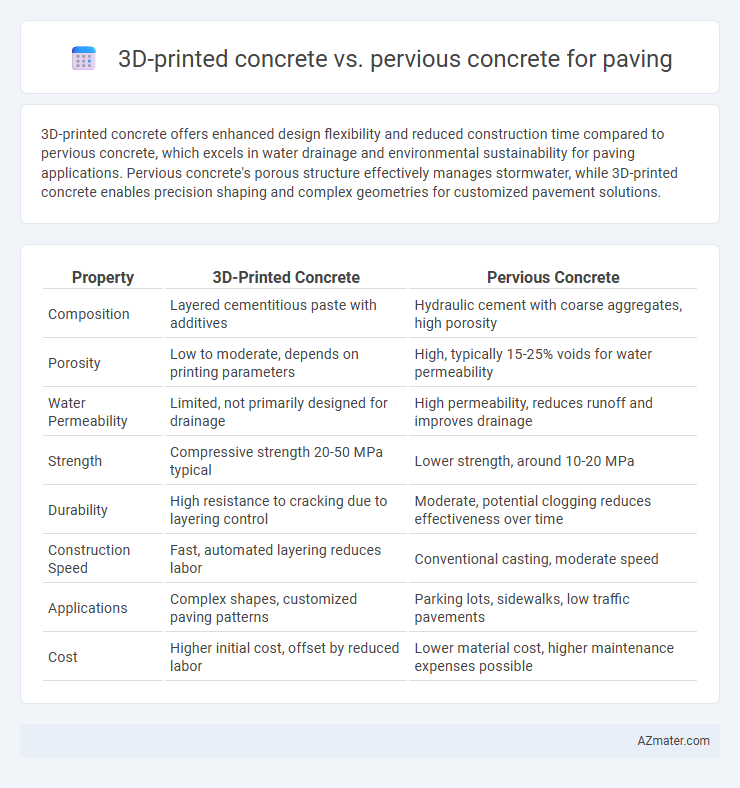3D-printed concrete offers enhanced design flexibility and reduced construction time compared to pervious concrete, which excels in water drainage and environmental sustainability for paving applications. Pervious concrete's porous structure effectively manages stormwater, while 3D-printed concrete enables precision shaping and complex geometries for customized pavement solutions.
Table of Comparison
| Property | 3D-Printed Concrete | Pervious Concrete |
|---|---|---|
| Composition | Layered cementitious paste with additives | Hydraulic cement with coarse aggregates, high porosity |
| Porosity | Low to moderate, depends on printing parameters | High, typically 15-25% voids for water permeability |
| Water Permeability | Limited, not primarily designed for drainage | High permeability, reduces runoff and improves drainage |
| Strength | Compressive strength 20-50 MPa typical | Lower strength, around 10-20 MPa |
| Durability | High resistance to cracking due to layering control | Moderate, potential clogging reduces effectiveness over time |
| Construction Speed | Fast, automated layering reduces labor | Conventional casting, moderate speed |
| Applications | Complex shapes, customized paving patterns | Parking lots, sidewalks, low traffic pavements |
| Cost | Higher initial cost, offset by reduced labor | Lower material cost, higher maintenance expenses possible |
Introduction to Innovative Concrete Technologies
3D-printed concrete introduces precise, layer-by-layer construction allowing complex designs and reduced material waste, enhancing sustainability in paving projects. Pervious concrete improves stormwater management by enabling water infiltration through its porous structure, reducing runoff and promoting groundwater recharge. Both technologies represent innovative advances in concrete paving, addressing environmental concerns and urban infrastructure challenges with distinctive functional benefits.
Overview of 3D-Printed Concrete Methods
3D-printed concrete methods utilize advanced additive manufacturing techniques that layer cementitious materials precisely to create complex and customizable paving structures, offering enhanced design flexibility compared to traditional methods. This technology often employs extrusion-based printers that deposit concrete mixtures with optimized rheology to ensure structural integrity and surface finish suitable for paving applications. Unlike pervious concrete, which prioritizes permeability for water drainage, 3D-printed concrete enables tailored mechanical properties and intricate geometries, making it ideal for innovative urban infrastructure projects.
Understanding Pervious Concrete and Its Applications
Pervious concrete, characterized by its high porosity, facilitates efficient water drainage, reducing runoff and promoting groundwater recharge, making it ideal for sustainable paving solutions. It consists of a carefully controlled mixture of cement, coarse aggregates, and little to no fine aggregates, which creates interconnected voids essential for permeability. Commonly applied in parking lots, sidewalks, and low-traffic roads, pervious concrete helps mitigate urban flooding and improve stormwater management while supporting environmental regulations and green infrastructure initiatives.
Material Composition Comparison
3D-printed concrete for paving typically consists of a specialized mixture with fine aggregates, cement, admixtures, and often fibers to enhance structural integrity and printability, while pervious concrete primarily contains coarse aggregates, less cement, water, and minimal fine materials to ensure high porosity for water permeability. The high solids content and tailored rheology in 3D-printed concrete enable precise layer-by-layer deposition, contrasting with pervious concrete's open-graded, permeable matrix designed for stormwater management. Material composition in 3D-printed concrete emphasizes strength and printability control, whereas pervious concrete optimizes aggregate size and void content to promote infiltration and reduce runoff.
Strength and Durability Analysis
3D-printed concrete offers enhanced strength and uniformity due to its layered deposition technique, resulting in reduced micro-cracking and increased structural integrity compared to pervious concrete. Pervious concrete provides excellent water permeability but typically exhibits lower compressive strength and durability, making it more susceptible to wear and freeze-thaw damage in high-traffic areas. When prioritizing durability and load-bearing capacity for paving applications, 3D-printed concrete demonstrates superior performance through optimized mix designs and controlled fabrication processes.
Permeability and Water Management Performance
3D-printed concrete offers precise control over pore structure, enhancing permeability and efficient water drainage, making it suitable for sustainable urban paving applications. Pervious concrete features a highly porous structure specifically designed to maximize water infiltration, significantly reducing surface runoff and promoting groundwater recharge. While pervious concrete excels in traditional water management, 3D-printed concrete allows customization of permeability levels to optimize performance in complex drainage systems.
Construction Speed and Efficiency Factors
3D-printed concrete dramatically reduces construction time by enabling precise layer-by-layer deposition without the need for traditional formwork, significantly improving site efficiency and labor utilization. In contrast, pervious concrete requires extended curing periods and careful handling to maintain permeability, which can slow down paving projects and increase labor intensity. The automation capabilities of 3D printing technology lead to faster project completion and lower overall costs compared to the manual processes involved in pervious concrete paving.
Cost Implications and Economic Considerations
3D-printed concrete offers significant cost savings in labor and material efficiency due to automation, reducing overall paving expenses despite higher initial equipment investment. Pervious concrete generally incurs lower upfront costs but may require more frequent maintenance and repair, influencing long-term economic sustainability. Evaluating lifecycle costs, including durability and maintenance, is crucial for informed economic decisions in selecting between 3D-printed and pervious concrete for paving projects.
Environmental and Sustainability Impacts
3D-printed concrete enables precise material use, reducing waste and energy consumption during paving construction, while offering the ability to incorporate recycled materials that enhance sustainability. Pervious concrete promotes groundwater recharge by allowing water to permeate through its porous structure, mitigating stormwater runoff and improving urban water management. Both technologies support eco-friendly paving solutions, with 3D printing optimizing resource efficiency and pervious concrete enhancing environmental resilience through natural filtration.
Best Use Cases: Choosing the Right Concrete for Paving
3D-printed concrete offers precision and rapid construction, making it ideal for custom-designed paving patterns and complex geometries in urban plazas or architectural walkways. Pervious concrete excels in sustainable stormwater management applications, allowing water infiltration for parking lots, driveways, and low-traffic roadways to reduce runoff and improve groundwater recharge. Selecting the right material depends on project priorities: aesthetics and intricate designs favor 3D-printed concrete, while environmental benefits and drainage needs best suit pervious concrete.

Infographic: 3D-printed concrete vs Pervious concrete for Paving
 azmater.com
azmater.com